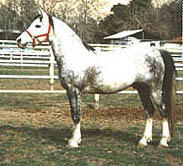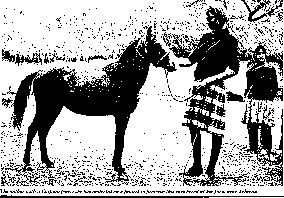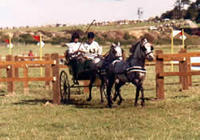 Iranian Horses
Iranian HorsesHorse (Equus Caballus)
Asb (in farsi)
This article on Iranian Horses Is from Iranzoo and breeds of livestock.
Horses In Pre-Islamic Persia
In Iran, skeletal remains of a native breed of small size, have been discovered in prehistoric sites: in a cave at Behistun (Bisotun), 48 km east of Kermanshah and in Tamtama, a mountainous area west of lake Urmia, in Tel-i Iblis, south-central Iran, and in Godin Tepe, central Zagros. This breed has tentatively been cosidered as the origin of the "Caspian miniature horse" now occasionally found in Mazandaran.
In Iran, we have late second-millennium archeological evidence from "Marlik" (objects made of horse teeth) and early first-millennium skeletal remains from "Gian", "Tepe Sialk", "Coga Zanbil", and "Susa". It is from this period that large quantities of "Lurisatn Bronzes" have been discovered, and among them are many harness bits and bridle pieces as well as items for decorating horses heads and chests, of the types which are depicted on Assyrian palace reliefs.
Bronze and iron harness and bridle pieces have been discovered at Median sites, also Assyrian annals record and reliefs depict campaigns in Media and Median tribute consisting primarily of horses. Especially praised were the horses of "Nishaya" > Nesa, south of Hamadan. Median levels at Nusheh-Jan near Hamadan have produced remains of horses of varied sizes, from miniature horses that stood 1.05-1.10m to horses standing over 1.50m at the witheres and variation from light to heavy types.
 Horses in Persian Literature
Horses in Persian Literature
From the dawn of history the Iranians have celebrated the horse in their art and in their literature. The importance of horses in the life of the Iranians assured them of a special place in Persian literature. Numerous poets have left poems in praise of or, occasionally ridicule of horses, sometimes with interesting observation about good and bad points in a horse. Iranian traditions abound with stories of famous horses and their significant roles in heroic and historical events: Rakhsh (the famous horse of the Hero Rostam), Shabrang (the horse of Siavosh), the stallion of Dariush, "Pasacas" so untamable a horse that only Cyrus the Younger could bring him under the saddle, "Shabdiz' the horse of Khosrow II Parviz (the king loved the courser so deeply that he had vowed to deprive of life whoever brought him the news of its death and so when it died, no one dared to reveal it to the king, and Barbad, the chief musician and minstrel, devised a trick and averted the king's wrath).
Some Persian sources such as "Ghabus-nameh" and "Nouruz-Nameh" have special chapters on horses, their colors and breeds.
Horses were also offered to gods, and the Aban Yasht celebrates many Iranian kings and heroes who sacrificed one hundred horses, one thousand oxen, and ten thousand sheep to "Anahita" asking her for special boons. An Avestan passage records that an excellent horse was worth eight pregnant cows. The qualities of a good horse were: swiftness, fleetness, endurance, and sharp eyesight. Of colors, white was the most praised, then came dun, redbrown, dark brown, and black. Strict rules were prescribed by the Avesta concerning the breeding, grooming, training, and feeding of horses and guardin them from diseases and harm.
Tazi (Persian-Arab)(Asil) Horse  It is said that origin of Arab horse is Persia. In Iran we call this breed az Asil, Tazi or Arab Horse. As we said before in the page of Tazi dogs, the word Tazi in farsi has 2 different means: (Arab and Galloping), and it's sure that what we mean about these 2 animals is a dog or a horse that gallops. But in the world and specialy in Western countries people call this breed az Arab Horse.
It is said that origin of Arab horse is Persia. In Iran we call this breed az Asil, Tazi or Arab Horse. As we said before in the page of Tazi dogs, the word Tazi in farsi has 2 different means: (Arab and Galloping), and it's sure that what we mean about these 2 animals is a dog or a horse that gallops. But in the world and specialy in Western countries people call this breed az Arab Horse.
This Horse Arab is known as the most beautiful and famous horse in the world which in actually it is the father of all oriental or hot- blooded horses. Asil Horse divides to some strains that the most important of them are: Kehilan, Hamdani, Saglavi, Obyan, and Hadban.
It comes in various colors Like: Bay, grey and white. Primary Uses of Asil Horses are: Cross-breeding and Riding. The center of Iranian Arabs in Iran, is Kerman, Khouzestan and some Tribes in southwest of this country.
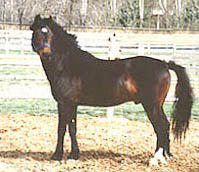
Caspian Horse

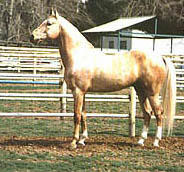
Turkaman Horse
Akhal-Teke Horse, a rare riding horse from Turkmenistan (evolved by the Teke and turkman tribes in oases, of Southern Turkmenia and also Turkman-sahra ), east of the Caspian Sea and north of Iran. This breed is one of the oldest horse breeds, almost for 3000 years. Although the Akhal-Teke and related types of horse have provided a base for the horse breeds of Asia and Europe, this breed is all that remains of the original fountainhead of horse breeds. An ideal horse for the desert, it is also known for its phenomenal powers of endurance. The breed became a modern legend in 1935 when several Turkamans completed an 84 day, 4128 km trip from Ashkhabad, Turkmenistan, to Moscow, Russia. This incredible journey, which included 966 km of desert with minimal rations of feed and water, has never been equaled.
The Akhal-Teke stands about 157.5 cm high at the withers (the high part of the back, located between the shoulder blades). Its long, narrow, tube like body has the fine, strong build typical of desert horses. The legs and back are long, and the withers are high. The long, slender neck is carried unusually high, joining the body at a 45 degree angle&emdash;a distinguishing characteristic of this breed. Large eyes and wide nostrils give the fine boned face a bold expression. Large ears are set wide apart.
It has a distinctive metallic, golden sheen overlaying a fine haired coat that can be colored dun (yellowish or bluish), bay (reddish), gray, or black. Its mane and tail are silky but sparse. It is ridden, raced, and used for show jumping, dressage (guiding a horse through a series of complex maneuvers with slight movements of the hands, legs, and weight of the rider), and competitive long-distance riding.
Turkaman breed has 3 many strains: Akhal-Teke: it is a pure turkman horse. Yamout: shorter and stronger. Chenaran: it is a hybrid of a Turkman and an Arab .

Dareshouri (Shirazi) Horse
It is a resistant horse and in some extent similar to Arabs and Kurds. This breed is usually kept in center of Iran (Fars).
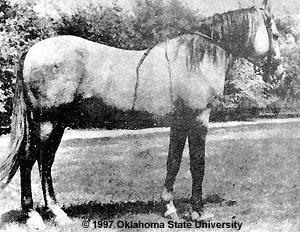 Baluchi Horse
Baluchi HorseThe Baluchi horse is found in parts of Baluchistan and Sind Provinces and districts of Bahawalpur, Dera Ghazi Khan, Muzaffargarh and Multan in Punjab Province. The color varies from bay, chestnut or gray. They are used for pleasure riding, tent pegging and for pulling 'tongas'. They are medium sized with a fine head, long neck, pointed ear tips touching each other, and the legs are fine and strong. In Pakistan, most of the horses are light in build and larger than ponies. Reminiscent of the Kathiawari of India, the Baluchi has very turned-in ears. Reports have stated that the Baluchi horse is related to the West African Barb through horses of Mali known as Beledougou, or Banamba.

Kurdish Horse
It is another small horse breed of Iran (with a high about 150 cm or lower). A strong and resistant horse ideal for mountainous roads. This horse is an ancient breed with a long history in Iran. There is three strains of this breed: Jaff, Afshari and Sanjabi.
The Jaf colors are mosetly: Bay, brown, chestnut, grey and it's Primary Uses if for Saddle
